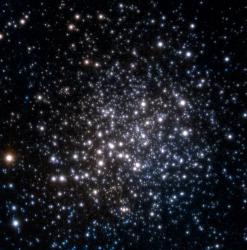Nov 26 2009
"The history of the Milky Way is encoded in its oldest fragments, globular clusters and other systems of stars that have witnessed the entire evolution of our galaxy," says Francesco Ferraro, lead author of a paper appearing in this week's issue of the journal Nature. "Our new study opens a new window on yet another piece of our galactic past."
 Peering through the thick dust clouds of our galaxy's central parts (the "bulge") with an amazing amount of detail, a team of astronomers has revealed an unusual mix of stars in the stellar grouping known as Terzan 5
Peering through the thick dust clouds of our galaxy's central parts (the "bulge") with an amazing amount of detail, a team of astronomers has revealed an unusual mix of stars in the stellar grouping known as Terzan 5
Like archaeologists, who dig through the dust piling up on top of the remains of past civilisations and unearth crucial pieces of the history of mankind, astronomers have been gazing through the thick layers of interstellar dust obscuring the bulge of the Milky Way and have unveiled an extraordinary cosmic relic.
The target of the study is the star cluster Terzan 5. The new observations show that this object, unlike all but a few exceptional globular clusters, does not harbour stars which are all born at the same time — what astronomers call a "single population" of stars. Instead, the multitude of glowing stars in Terzan 5 formed in at least two different epochs, the earliest probably some 12 billion years ago and then again 6 billion years ago.
"Only one globular cluster with such a complex history of star formation has been observed in the halo of the Milky Way: Omega Centauri," says team member Emanuele Dalessandro. "This is the first time we see this in the bulge."
The galactic bulge is the most inaccessible region of our galaxy for astronomical observations: only infrared light can penetrate the dust clouds and reveal its myriads of stars. "It is only thanks to the outstanding instruments mounted on ESO's Very Large Telescope," says co-author Barbara Lanzoni, "that we have finally been able to 'disperse the fog' and gain a new perspective on the origin of the galactic bulge itself."
A technical jewel lies behind the scenes of this discovery, namely the Multi-conjugate Adaptive Optics Demonstrator (MAD), a cutting-edge instrument that allows the VLT to achieve superbly detailed images in the infrared. Adaptive optics is a technique through which astronomers can overcome the blurring that the Earth's turbulent atmosphere inflicts on astronomical images obtained from ground-based telescopes; MAD is a prototype of even more powerful, next-generation adaptive optics instruments.
Through the sharp eye of the VLT, the astronomers also found that Terzan 5 is more massive than previously thought: along with the complex composition and troubled star formation history of the system, this suggests that it might be the surviving remnant of a disrupted dwarf galaxy, which merged with the Milky Way during its very early stages and thus contributed to form the galactic bulge.
"This could be the first of a series of further discoveries shedding light on the origin of bulges in galaxies, which is still hotly debated," concludes Ferraro. "Several similar systems could be hidden behind the bulge's dust: it is in these objects that the formation history of our Milky Way is written."